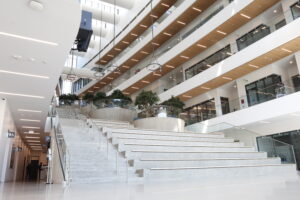<strong>By <a href=”http://159.203.128.194/tag/alison-roach”>Alison Roach</a></strong>
The project makes it easier to look at contracted muscles by speeding up the imaging process
James Wakeling, an associate professor of engineering and kinesiology at SFU, has developed a program with graduate student Manku Rana: a new, innovative, and non-invasive way of viewing human muscles. The duo use a combination of ultrasound imaging and 3D motion-capture technology to reconstruct the muscle. The key breakthrough of the project is the way the image is put together. “The process is new and different, the package that we’ve put together is different; it comes with its own specific problems and challenges,” Wakeling told The Peak.
Wakeling and Rana have been working on this project since September 2007 and the result is this sophisticated imaging tool. The new process is ground-breaking because it greatly improves the speed of imaging human muscles. Wakeling and his team are now able to image three muscles in the leg in 90 seconds, which is fast enough to be able to hold a muscle contraction during the imaging. This is a huge leap from the previously used method which would take 15 minutes, much too long to practically ask the patient to hold a contraction.
This imaging process also allows for a much greater range of muscle movement to be photographed than could be seen before. With the combination of methods, it’s now possible to reconstruct what the muscle looks like during contraction, using a compilation of views from two different angles. Currently, it’s almost impossible to determine the sources of the pressures that develop within a muscle and can affect movement.
The program has the potential to uncover new knowledge that will give insight into ailments and diseases that affect the muscles. “Up to now, we haven’t had the techniques available,” said Wakeling. He believes that for now, the program will prove to be an amazing research tool. “We will learn a whole lot of new, fundamental things about how muscles work, and about the structure of muscles . . . There’s a whole lot there that we know nothing about, with muscle contraction.”
The program, however, is nowhere near ready to be put into practice by the medical community. At the moment, Wakeling states that he can’t see more practical applications materializing. The imaging process is very much in an experimental stage, much too unrefined to be put into practical use. Right now, the next step is to fine-tune the method, and to use this new tool to look at muscle functions and how they contribute to movement. There’s a lot to be learned in this field, and Wakeling and Rana’s program is a huge step towards allowing these discoveries.













